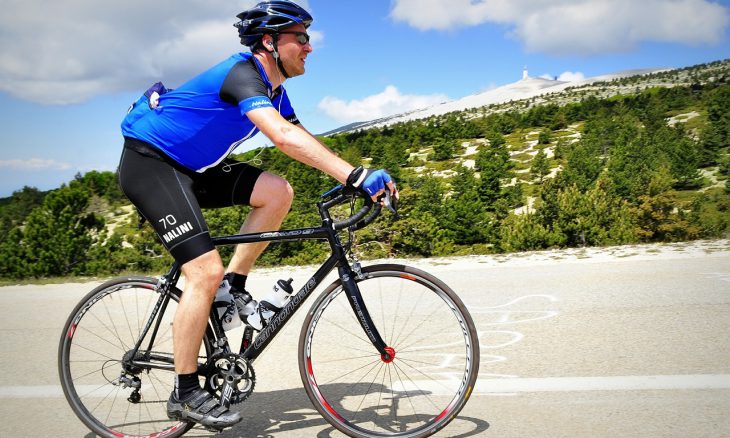I have been riding again after decades out of the saddle and I think there’s a lot I have learned from my newfound respect for the motorcycle that maps perfectly to social media marketing, both from my experience taking a Motorcycle Safety Foundation (MSF) and from the two years of riding experience I have gotten under my belt. I get to a point on social media eventually, so hang in there.
In only two years, I have owned two bikes, a very cool 650cc dirt bike and a very capable tourer. The first was a sexy lemon and the second, my current daily ride, is heavy-set, a little older, powerful, and comfortable — just like me. Oh, and purple.
Both riding motorcycles and managing online communities are dangerous. They both demand your full attention, complete preparation, careful forethought, intentional follow-through, route planning, and proper outfitting for a wide variety of eventual outcomes, even breakdowns and crashes.
Take A Safety Course
Even though I was a bike courier and have been riding bicycles for 40 years, and even though I took a Motorcycle Safety Course (MSF) course in Hawaii back in 1995, I took another one in 2011 while I was in Portland, Oregon, and then in 2012 — two years ago — when I was ready to buy my (second) motorcycle — right here in Alexandria, VA, at the NoVa campus here, offered by MSF. There’s too much to lose by making easily-preventable mistakes at all on a motorcycle.
Taking a spill or two in the wild during the learning process can result in the loss of property if you’re lucky, and the loss of life if you’re not. Spend the money hiring a professional to train you up, put you into real life situations, some scenarios, in controlled situations and safe environment.
In the case of motorcycle-riding, we just spent a very intense weekend going through books, videos, Powerpoints, and then lots of time on a small, light, easy-to-control practice bike. The same thing with social media: just because you can use Facebook and follow folks on Twitter doesn’t mean you know how to do social media marketing or be a digital PR professional.
Get some training, hire a professional, work on your foundation. One of the things I rolled my eyes at when I was on the tarmac of the parking lot we used for live practice at Northern Virginia Community College were the endless swerving, turning, merging, stopping, starting, acceleration, and deceleration practice repetitions. I doubted their process.
Why? Because they were motorcycle nerds! But, you know what? I have used every single thing I have learned in those three days to get myself and keep myself out of trouble.
Hire someone, get some humility, learn something, taking some advice, and do the work required to really internalize what you’ve learned, well before any of those outrageous and pedantic exercises have come-to-pass. They all come to pass, eventually.
And, when you meet that outrageous, unimaginable, theoretical, scenario face-to-face, you’ll be happy you did. (In fact, MSF even teaches you how to engage siccing dogs — it’s a vectoring thing — and squirrels that can’t decide which way to go and are frozen in the road right in front of you (don’t swerve, just run ’em over).
Buy The Best Gear You Can Afford
While, it’s very cool to ride around in a T-shirt, jeans, and sneakers. Yes, a helmet, but no gloves. No armor. No protective boots. But smart riders wear their armor every day, not matter how hot, sunny, or humid the summer may well be. Same thing goes for social media engagement. Use your process. Follow your plan. Use your message models.
Follow your work flow. Keep track in HootSuite or Sprout or whatever you use. I know you’ll want to just wing it. I know you might not even be using SocialOomph, Sprout, HootSuite, Radian 6, Sysomos, SM2, or any of them, but you should find some tools — the best tools you can afford — and stop winging it.
Come up with a plan and stick with it. Use the best tools you can use. I have even started using Desk.com in order to best track my main social profiles, all in one place, sort of like an Inbox.
Begin With A Starter Bike
When I started, I wanted to rush out and get a 1,000cc bike. With a liter engine. An engine as big as the SMART. At the MSF, we trained on 125cc and 250cc bikes. Standards, cruisers, and dual purpose bikes, upright and comfortable. Light, maneuverable, nimble, underpowered, a little banged up, but simple to use, control, brake, accelerate, and recover from mistakes. And, when you inevitably lose balance, tip over, or fall, there’s a lot less chance that there will be an injury — and that you’ll want to get back on that iron horse.
I was so reassured by the ease with which I navigated my 250cc starter bike, a fat-tired dual purpose number, that I purchased a used 650cc dual purpose motorcycle.
Most folks go in for a small Ninja but I am a bear of a man at north of 250 pounds and 6’3″ — I would have crushed a little bike. But I digress.
People really want to start big. They want to over-commit. They want to jump in, feet first. This is terrible in all ways. Google is wary of severe SEO front loading, rightfully so. If you over-commit to blogging, a newsletter, list-building, Facebook, Facebook Pages, Google+, Twitter, Pinterest, Tumblr, and spend all of your time, energy, best ideas, and passion well before you’ve gotten any traction.
You’ll waste all that energy spinning your wheels, out of control, you’ll become easily overwhelmed, you’ll lose your focus, become distracted, frustrated, confounded, and then maybe just get spooked by all the power, responsibility, all that noise!
You might just feel like hanging up your helmet. Most neophyte social media marketers, at whatever level, tend to get so wiggly about all the cool things that they’ll be able to do by leveraging the power of MailChimp, Facebook, Google AdWords, Twitter, Pinterest, mobile, apps, and the blogosphere — and it is exciting, too, indeed — but if you jump right on that 1300cc Suzuki Hayabusa GSX1300R and twist hard on that throttle, you’ll surely make it to sixty in 2.47 seconds and probably even reach 194 mph — once.
When social media newbies toss their leg over their brand new social media superbike, they’ll more than likely end up exhausted, scared, emotionally scarred, freaked out, and — if you haven’t put yourself into the hospital — you’ll put that $15k bike right up there onto Craigslist for a fire sale, never to return. Even worse, they’ll blame the bike instead of themselves!
Social media should be waded into over time. Each little piece should be engaged with carefully and completely. The frequency and intensity of the social media engagement should be considered carefully. Once you engage on social media you’ll need to keep on engaging forever.
I hate to perpetuate the apocryphal myth that the average lifespan of a motorcyclist after he takes up riding is five years but it’s useful here: the average lifespan of a blogger after he takes up blogging is only six months. Don’t kill yourself.
You need to keep safe, happy, comfortable, rested, awake, focused — and alive! — long enough for everything to come together. Don’t rush it, don’t push it, take it easy, stop a lot, and if you’re ever getting too tired, pull over and grab a room. Or, in the name of social media, set up your editorial calendar compassionately enough so that you can persist indefinitely.
Over time, and surely after month six, you’ll start finding your pace, you’ll start developing your voice, you’ll start building real relationships, and you’ll even start making friends and identifying your true fans, ambassadors, and influencers.
Even through riding is cool, it really isn’t very enjoyable for the first year; then, they say, after a few more years you become complacent. The trick is to keep your vigilance, focus, and attention while you’re indulging in the fun, challenge, and excitement of getting out there and doing it, be it on the open road or the information superhighway.
Be that as it may, social media is just like riding in one more really important way: while experience is one of the most valuable acquisition for both social media and motorcycling, every morning is a new day. Motorcycling and social media are stateless.
Even if you commute to work every day along the same route like clockwork, they route will never be the exact same twice. And, to be honest, one false move could possibly kill you. Put you into a hospital bed for a year. Social media can be dangerous, too.
Just because they’re both fun — and become even “funner” the more experiences you collect, the more hours you have in the saddle — they’re still dangerous games.
You’ll expose yourself every day to the entire world, to situations you may well have practiced for but maybe never experienced, you expose yourself to other people’s whims, moods, anger, patience.
You’ll expose your vulnerable body to the dangers of things like Volvos, Trolls, Potholes, Haters, and Volvos. Most days, everything’s boring and lovely.
Most of the time, you’ll arrive at the end of the day with just the buzz of the bars and the grit of the day. Most of the time, you’ll engage with your natural allies online, most of the time comments are insightful and generous. Most of the time, that Volvo driver signals before he merges instead of just sort of merging into your lane while you’re in it (Oh, I really hate Volvo drivers). Anyway, complacency kills.
Failing to prepare, every single day, can be catastrophic. It’s not so much of an issue any more with my new-to-me 1995 BMW K1100LT touring bike, but my 2002 Honda XR650L desperately wanted to kill me. The tires leaked, it burnt oil, it skittered on knobby tires, the tank was small and didn’t have a gauge, and it was air-cooled so it over-heated — and that was before I even got out onto the road. I needed to check its road worthiness every single day.
If I didn’t, a tire might roll off or the engine might seize up. Unlike the car you can just jump into and head out to work, some bikes need to warm up a little before heading out. You need to choke them to life. You need to listen to the engine, recognize its temperament, health, happiness.
It sounds trite, but you really need to make the bike a true extension of yourself while also listening and feeling for shudders, squeaks, skitters, grinds, thunks, and whines that you’re unfamiliar with.
Like a spider on the web, you’ll also need to build that same sort of connection with your community online, be it through the looser associations you might make through Twitter all the way to the very intimate interactions you can have on Listservs, message boards, and blogs.
But, like the vibrating of a spider’s web when something touches the threads of its web, you need to become one, if you will, with what normal and healthy sound and look like with your community.
With both your riding life and your social media life, you need to spend some time getting to know your platform and then you need to build your routine, your base-line, you need to define your normal, and then you need to remain forever vigilant and attuned to danger.
And then you need to be well-practiced, well-rehearsed, and well-prepared enough so that you’ll be able to anticipate what will probably happen next after that warning sign trumpets. Can you anticipate the crisis? Can you prepare so that you’ll not need to react but act?
Swerving isn’t reaction, it’s action. Getting up off the saddle in order to allow your arms and legs to take the brunt of hitting that pothole or that two-by-four piece of wood (wood that may very well be full of protruding nails).
Just keep your eyes on the road, it’ll be a long happy ride. Relax, get comfortable, and keep well within your skills and limits.
Go git ’em, Tiger!
Feel free to email me at chris@gerr.is or call me at +1 202-351-1235
Learn more about Chris Abraham at Gerris digital.





